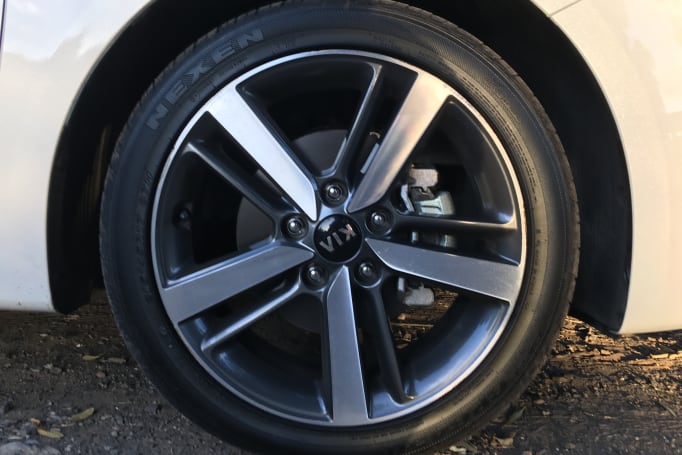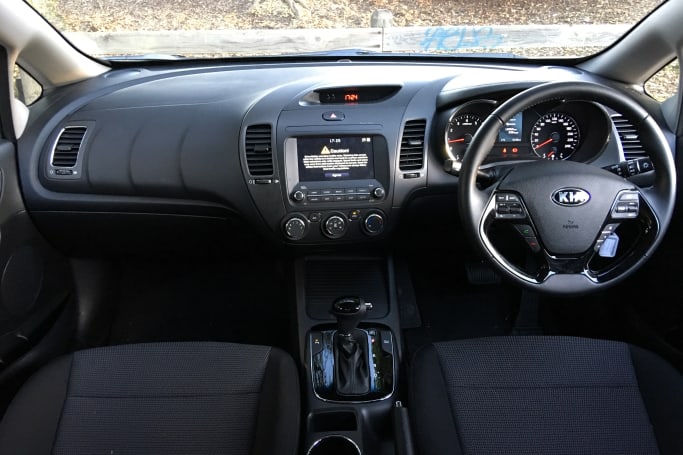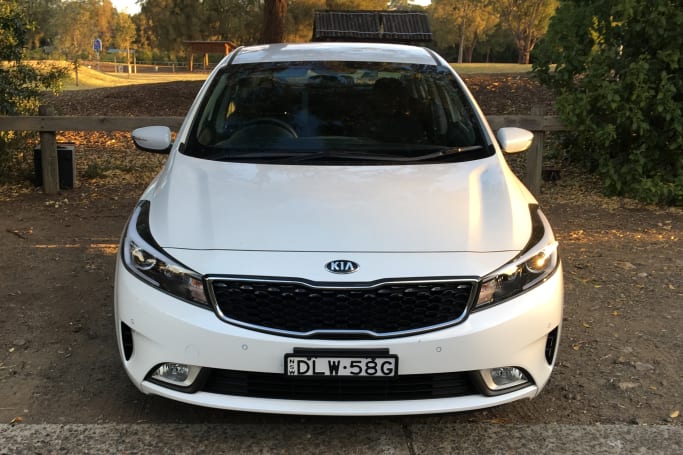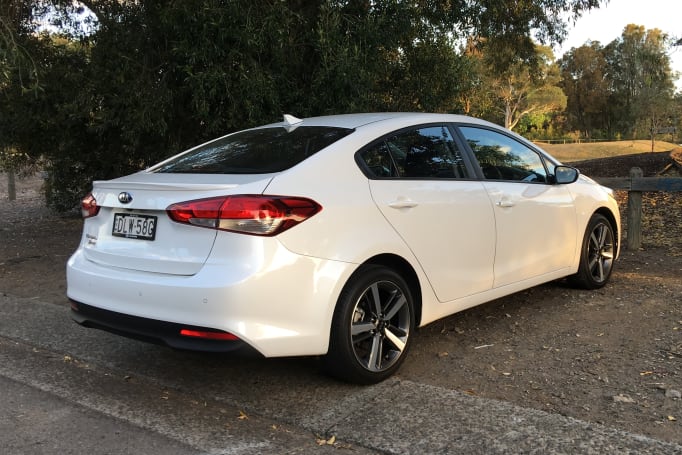
Toyota Corolla 2017 review
The Toyota Corolla. A small car that's been part of our local landscape since 1967. Not many cars can come close to making a claim like that. So how does the latest incarnation shape up?
Browse over 9,000 car reviews

It is no real secret that the motoring world is guilty of criminal misuse of the English language ("polarising" design, for example, actually means that everyone who has ever seen it hates it, with the possible exception of the person who designed the car) but no single term is so outrageously abused as the word “sport”.
You can have everything from a humongous Mazda CX-9 to a tiny Toyota Corolla in the alluring-sounding Sport guise, only to find yourself behind the wheel of a car as performance-ready as Clive Palmer wheezing away on a treadmill.
And we can safely add the Kia Cerato Sport sedan to that ever-growing list. While Kia’s fetching small sedan (which might be one of Australia’s best-value new cars) is a lot of very good things, sporty simply ain’t one of them.
Luckily, then, it’s got a few other aces up its sleeve.
| Kia Cerato 2017: Sport | |
|---|---|
| Safety rating | |
| Engine Type | 2.0L |
| Fuel Type | Regular Unleaded Petrol |
| Fuel Efficiency | 7.3L/100km |
| Seating | 5 seats |
| Price from | $16,280 |
Kia’s glorious reluctance to trouble you with an options list is in full swing with the Cerato Sport, which starts at $24,790 and arrives with enough standard equipment to ensure the price won't move too much.

Outside, expect 17-inch alloy wheels (and a full-size alloy spare), remote unlocking, heated and electric wing mirrors, dusk-sensing headlights, fog lights and a tiny boot-lid spoiler (so sporty). Inside, expect cloth seats, cruise control and power windows front and rear.

It’s the tech stuff that’s impressive, though, with a seven-inch touchscreen that’s both Apple CarPlay and Android Auto-equipped, pairing with a six-speaker stereo taking pride of place in the dash. Navigation is standard, too, and everything is easy to control and understand.

From the outside, it looks terrific. Our white test car was fitted with cool-looking black-and-silver alloys, and the way the headlight design feeds into the body work gives the Cerato Sport sedan a sleek and sporting profile. It looks great from the front, too, with a silver-rimmed black grille that blends into these power creases on the bonnet.

The interior, though, isn't quite as impressive. It's nicely laid-out and feels well put together, but the ribbed plastic lining the glovebox doesn't work for me, while the infotainment screen feels a bit clunky and old-school compared to the best in the business.

One interesting design quirk is that you can't open the boot from outside the vehicle, and there's no button to open it anywhere on the key. Instead you need to open the front door and pull a lever down by the driver's seat - frustrating when you arrive with arms full of shopping.
At 4560mm in length and 1780mm in width, and riding on a 2700mm wheelbase, the Cerato falls firmly into the small-sedan category, but there's still enough room to move in the cabin.
The two front seats feel light and airy, and are separated by two cupholders in the central console, and there's a a bonus storage bin under the air-con controls that can be hidden beneath a sliding cover, and is also home to two power sources, a USB connection and an Aux-in cable.
The backseat divider is home to two more cupholders and there's room in each door for bottles, but a strange design quirk sees the storage bin that separates the front seat protruding into the rear riders' leg room.
There's no back-of-seat storage either, and nor are there any air vents, power or USB connections back there, but there are two ISOFIX attachment points - one in each window seat.

While the boot opening limits the size of the parcels you can squeeze in, there's 482 litres (VDA) on offer, and a full-size spare hidden below the flat-load shelf.
As there is exactly one engine offered across the Cerato range, there are no prizes for guessing the powerplant nestled under the bonnet of our Sport sedan.
The naturally aspirated 2.0-litre petrol unit will produce 112kW at 6200rpm and 192Nm at 4000rpm. It's paired with a six-speed automatic (which Kia calls a Sports-matic, further proving our earlier point) and sends its power to the front wheels. Does 112kW sound sporty to you? Or anyone?
The Cerato Sport will sip 7.2 litres per 100 kilometres on the claimed combined cycle, and will emit 168g per kilometre of C02.
As always, though, treat those numbers as something of a guide; we were seeing 10.4L on the on-board computer by the end of our test.
There are many, many moments of disappointment in the world of new cars, mostly when you finally climb behind the wheel of something you've been eagerly waiting to try, only to find it doesn't live up to its own hype or your expectations.
The Kia Cerato Sport sedan, happily, is the exact opposite, in that you don't necessarily expect it to shine quite so brightly on the road as it does, and you're genuinely left pleasantly surprised when it does.
Our fairly comprehensive test took in plenty of urban, suburban and freeway roads, and the Cerato handled all with ease. It's not that it ever feels powerful or particularly athletic, and you'd be unlikely to turn up at your local track day in one, it's more that the ride - which has been tuned locally - feels so perfectly suited to its day-to-day duties, blending dynamics with a supple quality that really impresses.
The man behind that ride is Aussie tuning ace Graeme Gambold, and he tells us that, following the Cerato's mid-life update last year, the Korean factory took his advice and made the torsion beam rear axle thicker, allowing more scope in the tuning.
"A car that handles well also rides well," he says. "Just because a car is hard, doesn’t mean it handles well.
"Generally when the cars come from Korea, the domestic specification is pretty soft. So we tend to try and give them more roll stiffness. Put simply, we focus on the up-and-down movement, which means compliance, while minimising the side-to-side movement."
Vision is easy from the front seat, too. And while it can be noisy and a little harsh when you really ask too much of the engine, if you keep it at city speeds and go easy with the acceleration, it'll happily cruise about in quiet-enough comfort.
Basic Warranty
7 years / unlimited km warranty
ANCAP Safety Rating

The Cerato Sport arrives with six airbags, front and rear parking sensors and a reversing camera as standard, all of which join the usual suite of traction and braking aids. Advanced tech - like lane-departure warning, forward collision warning and AEB - don't make an appearance at this trim level.
The best in the business, it's that simple, with a seven-year, unlimited-kilometre warranty combined with capped-price servicing. The Cerato's service intervals are pegged at 12 months or 15,000km, with prices ranging from $289 to $437 per visit to the dealership.
Kia's Cerato Sport is a handsome and feature-packed offering that's a genuine pleasure to pilot. The interior is less than inspiring, and it's lacking some key standard safety equipment, but it still adds up to a very convincing package at its price point.
| Vehicle | Specs | Price* | |
|---|---|---|---|
| Koup Si | 2.0L, ULP, 6 SP MAN | $14,410 – 19,030 | 2017 Kia Cerato 2017 Koup Si Pricing and Specs |
| S | 2.0L, ULP, 6 SP MAN | $12,210 – 16,280 | 2017 Kia Cerato 2017 S Pricing and Specs |
| S (AV) | 2.0L, ULP, 6 SP AUTO | $14,080 – 18,590 | 2017 Kia Cerato 2017 S (AV) Pricing and Specs |
| S (AV) | 2.0L, ULP, 6 SP AUTO | $12,980 – 17,270 | 2017 Kia Cerato 2017 S (AV) Pricing and Specs |
| Price and features | 7 |
|---|---|
| Design | 7 |
| Practicality | 7 |
| Under the bonnet | 7 |
| Efficiency | 7 |
| Driving | 8 |
| Safety | 6 |
| Ownership | 8 |
$11,525
Lowest price, based on 230 car listings in the last 6 months